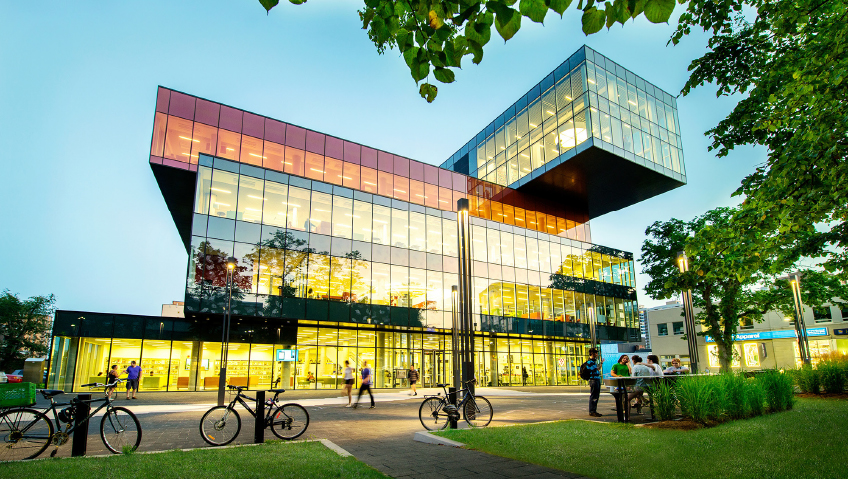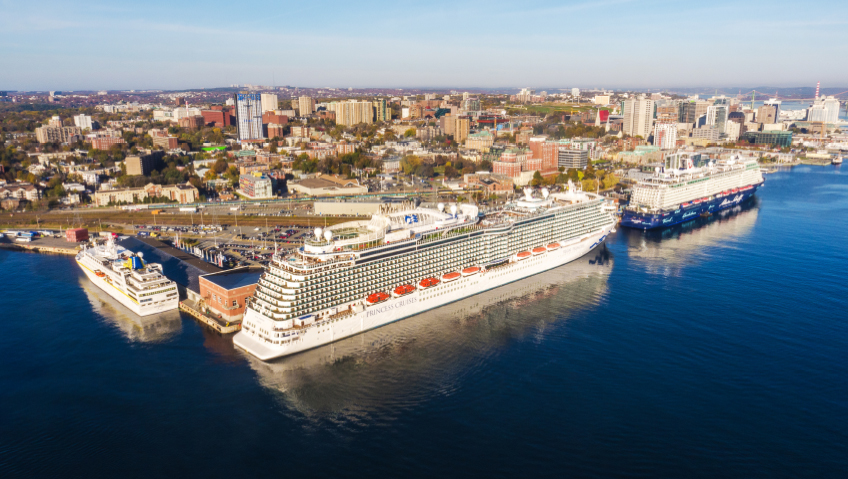Located on the west coast of Newfoundland, Canada, the City of Corner Brook, with its thriving arts and cultural scene, natural attractions, and burgeoning cruise line industry, is poised to become a provincial leader in tourism. Boasting the province’s second-largest population behind St. John’s, this most northern city in Atlantic Canada offers year-round events and outdoor activities for visitors of all ages to enjoy.
Although businesses around the world have experienced the repercussions of a pandemic that has severely restricted travel and cancelled thousands of popular events over the past several years, the tourism industry has perhaps taken the biggest hit, devastating smaller venues in particular. Corner Brook is determined to rebuild, however, and at the helm of this revamp of is Tourism Coordinator Glenda Simms, whose experience and enthusiasm are helping to revitalize a community.
“With COVID, tourism was the first to go down and the last to come back because there are so many sectors and areas impacted,” she says. “So it needs to be a really collaborative rebuild. Collaboration is key.”
That collaboration isn’t only found in local businesses eager for a rebuild, but in organizations such as the Atlantic Canada Opportunities Agency (ACOA), which works to help fund economic growth in the region through innovation, diversifying local economies, and championing the region’s many strengths. And Corner Brook has no shortage of strengths: from festivals and events to cruise ship ports, mountain ranges and stunning natural wonders, the reasons to visit are abundant.
Simms, with a background in cruise ship employment and strong ties to the area, is the perfect person to champion the city’s assets, which include a bounty of festivals making a reappearance in 2023. “Our goal is to take some of the festivals we were able to start this year and move into 2023 and build on them,” she says.
Jigs and Wheels, for instance, is a popular 10-day festival in July that features local artists and music, a Blame It On Broadway day, Ribfest, Christmas in the Park, a family kite flying event, dog walks, hikes, and plenty of outdoor activities—in short, a jam-packed festival with something for everyone to enjoy.
“We also open the community up for ATV use,” Simms says. “If you have a licensed ATV, you can drive around the city, do an ATV parade, a scavenger hunt, and tours with ATVs.”
The Colours of Corner Brook Festival, a harvest festival that Simms is looking to make an annual event, is centred on the largest cruise ship arrival closer to the end of the season in the beginning of October. Colours of Corner Brook features local musicians, crafters and traditions, all while hay bales and pumpkins adorn the streets.
One of those shared traditions is Mummering, typically a traditional Christmas amusement that involves participants (known as mummers) dressing up in wild costumes, donning masks or wearing veils over their faces, and distorting their voices, all in an attempt to avoid being recognized.
Other successful and popular events include a Corner Brook Day Celebration, National Indigenous Peoples Day, Canada Day, and a Winter Carnival. The city’s Halloween event features “spooky” rides on the extremely popular Mill Whistler Road Train, a little red train that holds 36 people, is wheelchair accessible, and is used for many activities throughout the year, including seniors’ outings, special needs classes at the elementary school, and sensory-friendly rides for the Autism Association.
“If anyone who reaches out who really wants us to do a special ride for the train, we will do so,” Simms says. “It goes on all year long when the weather is good!”
Along with the wide variety of local festivals, Corner Brook will also welcome over 30 cruise ships in 2023. The Port Authority, through ACOA, is already working on increasing the aesthetic appeal at the harbour with a new park to welcome cruise passengers.
“Passengers will take shuttle buses up and get dropped off into the ‘City Centre,’ Simms explains. “We have the train, music playing, and vendors all set up in the square selling local crafts and art, or handing out apple cider or apples, so we do encourage downtown businesses to be involved for the cruise ship welcome.”
While most people recognize St. John’s as the key port for Newfoundland, Corner Brook is actually a bigger port. It can handle larger ships than any other port in the province and the journey through the Bay of Islands is nothing short of stunning.
“We had a captain from Norway who gave us a tour of his ship who said it made him homesick coming in the Bay of Islands because it’s so comparable to Norway with the beauty,” says Simms. “A lot of times I think people don’t realize what’s right in their own backyard, or right out their front window, because they’re so used to it. To visitors, our City and Island is considered an exotic destination.
Simms, who personally has visited hundreds of ports during her time with the cruise line industry, says the Bay of Islands is probably one of her top five sail-ins. “A lot of people I know have sailed in the water there and they often talk about how breathtaking it is coming in that bay,” she says.
Simms’ enthusiasm is infectious, and her love for her city is undeniable, making her a qualified and genuine fit for a role that didn’t previously exist. “Council was wise enough to see that tourism is something that would be beneficial here with the cruise industry building up so quickly and cruise ship numbers increasing as well over the past few years,” she says. “There is definitely a lot to do here, with traffic from the cruise ships and beautification programs. We have a lot of volunteers, a lot of local vendors and musicians and artists, so it’s definitely an area that will be impacted well by the cruise industry in the near future.”
Corner Brook has also started a new public art initiative with the goal of bringing art, artists, and audiences into the public space with the goal of adding enormous value to the cultural aesthetic and economic vitality of the community.
“Temporary art creates a powerful sense of place which is unique and dynamic,” Simms says. “There’s a big fine arts community here because we’re home to the only School of Fine Arts for Newfoundland. The public art initiative is to encourage a lot more public art for visitors to see, as well as for artists to be able to share what they’re doing while they’re attending school as well.”
One of Simms’ favourite art projects is the Corner Brook sign, a colourful local sign comprising five-foot high letters with each letter featuring images of cultural or historical significance to the city, including sports, Indigenous culture, the train, and the fishing industry.
“I wanted every letter in the sign to tell a different story,” says Simms. “Every time I came home from my contracts at sea, I always had stories to tell. I love for this to be a place where stories can begin. I want to be able to have visitors come here and have our area or their visit here to be a page in their story that they share.”
When Simms took her grandparents to see the sign, her grandfather, who worked at the mill all his life was “so excited” to see that one of the letters was a mill whistle, while her grandmother, who is from the Indigenous community, was happy to see another letter features Mattie Mitchell, an Indigenous Mi’kmaq representative. “All of our grandparents helped build the city,” she adds. “I go to them for history lessons!”
Moving forward in the wake of COVID, Simms aims for more of these types of projects and further rebuilding, with help from the STAR program, the Strategic Tourism in Areas and Regions initiative funded by the provincial government as well as ACOA. The program brought in a consultant who addressed both Corner Brook and surrounding municipalities and produced a tourism report of 31 recommendations to help rebuild the tourism industry through branding and marketing. Simms is grateful to both of these organizations for the assistance and mentorship they’ve provided.
“Representatives for ACOA were absolutely wonderful,” says Simms. “The relationship is great. They’ve been walking me through it at my pace and not been at all pushy or impatient. The team there has been great with us.”
The organization has been instrumental in working with the city as it now examines its updated STAR report which addresses the challenges of branding, marketing, festivals and events through a COVID lens.
Those COVID challenges of course also include the damage brought to numerous businesses that now require a level of support to find their footing and welcome visitors back to the area, but Simms is positive that Corner Brook will bounce back in all respects.
“I think this city handled it quite well,” she says. “The main thing was to ensure the residents and visitors were cared for, but we also want them to feel like it’s comfortable to visit here. We have things in place that will allow their visit to be safe and comfortable. We’ve been building up the downtown core and we’ve been really listening to the residents’ and visitors’ feedback and trying to do as much as we can to support the revamp of tourism.”
With branding and marketing underway and ongoing assistance from ACOA to help restore potentially popular tourist sites, the City of Corner Brook is looking toward a spectacular future.
“You have to start with your locals,” says Simms. “If you want visitors to come, you have to have your locals love to live there as well. The key word is collaboration, and as long as we all work together, I think that we can make this a great destination of choice.”






